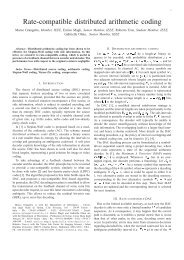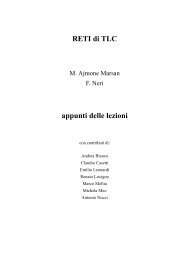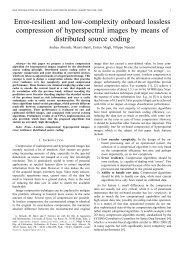Transform coding techniques for lossy hyperspectral data compression
Transform coding techniques for lossy hyperspectral data compression
Transform coding techniques for lossy hyperspectral data compression
Create successful ePaper yourself
Turn your PDF publications into a flip-book with our unique Google optimized e-Paper software.
IEEE TRANSACTIONS ON GEOSCIENCE AND REMOTE SENSING (SUBMITTED DEC. 2005) 9<br />
single spectral decomposition tree has to be transmitted, instead of a separate tree <strong>for</strong> each spectral<br />
vector.<br />
Best basis selection using the <strong>coding</strong> gain yields the decomposition represented in Fig. 4.<br />
Consistently with the notion that spectral vectors have a significant in<strong>for</strong>mation content, the obtained<br />
decomposition is finer than the classical dyadic wavelet tree in the high-frequency portion of the<br />
spectrum, and almost resembles a Fourier trans<strong>for</strong>m.<br />
L<br />
H<br />
L H L H<br />
L H L H L H<br />
Fig. 4.<br />
Best basis <strong>for</strong> the spectral DWPT.<br />
5) Hybrid spectral wavelet packet trans<strong>for</strong>m and spatial wavelet packet trans<strong>for</strong>m: In this method<br />
a wavelet packet decomposition is applied separately in the spectral and spatial dimensions. The cost<br />
function is minimized in the third dimension considering the cube obtained by the 1D DWPT; then,<br />
a 2D DWPT is evaluated on each single band.<br />
6) Hybrid spectral discrete wavelet trans<strong>for</strong>m and spatial wavelet packet trans<strong>for</strong>m: In this method<br />
a DWT is applied in the spectral dimension, while a 2D DWPT follows in the spatial dimension.<br />
7) Spectral discrete cosine trans<strong>for</strong>m and spatial discrete wavelet trans<strong>for</strong>m: This method applies<br />
a one-dimensional DCT trans<strong>for</strong>m to each spectral vector, and a 2D square DWT on each single band<br />
of the obtained trans<strong>for</strong>med cube.<br />
8) Spectral KLT and spatial DWT: This method applies the KLT in the spectral dimension followed<br />
by the 2D square DWT along the spatial dimensions. In order to evaluate the trans<strong>for</strong>m matrix which<br />
optimally decorrelates the spectral dimension, we estimate the covariance matrix of the <strong>hyperspectral</strong><br />
<strong>data</strong> cube assuming that each spectral vector, containing the radiance of a pixel at a given spatial<br />
location in all the bands, is a realization of the random process that has to be decorrelated.






